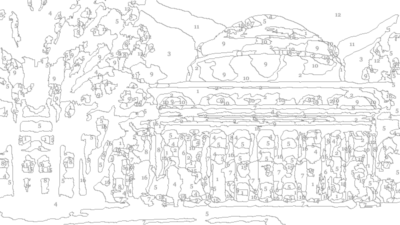
Painting by number by David duKor-Jackson
The anti-formula

image generated by pbnify.com
In a rant post many years ago, I referenced the concept of students completing elaborate “paint by number” applications that could often be appealing at first glance, but ultimately turn out to be woefully short on substance. I want to revisit and elaborate on that notion because it remains apropos today as students continue to seek ways to unlock the secret formula to secure admission.
For starters, I can not argue with the logic of trying to discover the formula for admission, (even though there isn’t one). This is MIT after all. We love formulas. When you combine the idea of creating an image based upon numbers, surely this is kismet. Because the only thing we love more than formulas is numbers, or at least that is what people think.
There are actually quite a lot of things that we love. We love learning. We love solving hard problems. We love to collaborate. We love to express ourselves creatively, and perhaps most importantly, we love to do all of these things, and many more, simultaneously.
As such, the very idea that one can somehow orchestrate and compile a specific sequence of events, activities and accolades that will guarantee admission is completely antithetical to everything that we are about.
Let me go back to the concept of painting by number. While the finished product could resemble a masterpiece, generally the best that it can aspire to be is a convincing counterfeit, which is typically not what we are going for when selecting students for our class. It is also worth noting that many may take inspiration from the same idealized portrait of excellence, which frequently delivers a collection of submissions that are virtually indistinguishable from one another. In those situations, a new interpretation, spawned either by creative license or necessity, given the available resources, may stand out from the crowd.
I know that this is difficult to reconcile for many students (and their parents) who have carefully curated portfolios designed to impress. On the surface, they have done everything “right,” but the “how” and “why” are just as important as the “what.” So when the fundamental response to “how” is that it was facilitated by parents and their connections rather than through individual initiative on the part of the student, or the “why” is because it will look good rather than because students are pursuing an area of genuine interest, the “what,” regardless of how impressive it may seem, loses a lot of its luster.
Institutionally, we aspire to work wisely, creatively, and effectively for the betterment of humankind, working with others to bring knowledge to bear on the world’s great challenges. None of that is achievable by simply following a path that has been blazed by others. It is essential, therefore, that students who aspire to be the creators and innovators of tomorrow engage in pursuits today that lay the groundwork for the challenges ahead.
A few things that I would suggest:
- Learn to prioritize and balance. YOU CAN NOT DO EVERYTHING! So you should not try to. If you have trouble figuring out what you should do…
- Pursue areas of genuine interest (or dare I say, passion). If there is not anything that you are genuinely interested in, then you probably need to keep looking. Try new things. Keep investigating and exploring until you find something meaningful to you. And finally…
- Achieve more than is expected of you. Do what is achievable, rather than what is simply sufficient. Don’t limit yourself by asking what do I need to do (which can also be read “what is the minimum that I need to do”) in order to earn this grade or gain admission? Do what you are capable of.